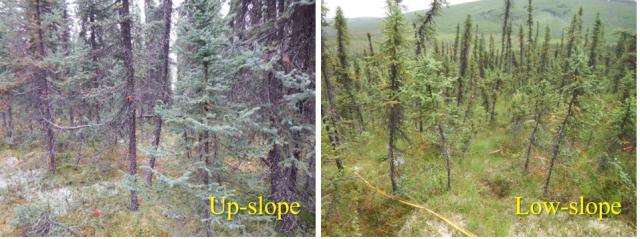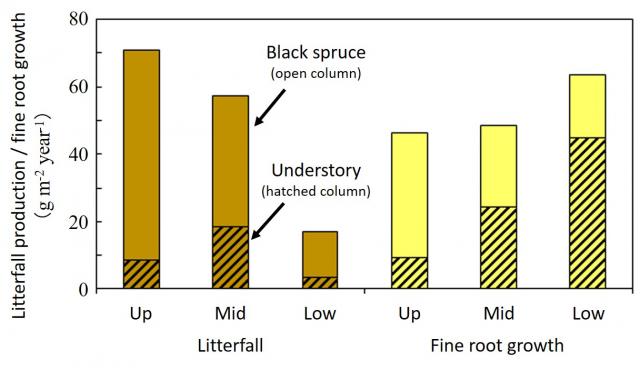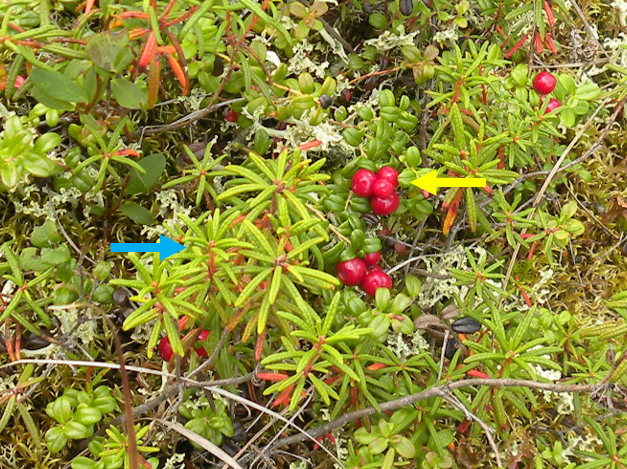Home > International Partnerships > Collaborative Research > Carbon Dynamics in Permafrost Forests with Different Active Layer Depths
Update:October 25, 2022
Main content starts here.
Carbon Dynamics in Permafrost Forests with Different Active Layer Depths
1. Partners
International Arctic Research Center (IARC), University of Alaska Fairbanks, United States of America
2. Research Period
FY 2016-2022 Grant-in-Aid for Scientific Research (KAKENHI)
3. Lead Researcher
NOGUCHI, Kyotaro
4. Background
Carbon stocks in boreal forests are considered equivalent to those in temperate and tropical forests. More than 20% of boreal forest area is underlain with permafrost, where huge amounts of organic carbon are stored in frozen soils. However, there is a concern that rising temperatures caused by climate change will lead to permafrost melting, resulting in permafrost forests becoming a source of greenhouse gas emissions. Therefore, it is essential to understand the complexity of carbon dynamics in permafrost forests, as well as the effects of biological processes such as plant growth or respiration on the carbon dynamics.
5. Research Goal
The aim of this study is to understand carbon dynamics in black spruce (Picea mariana) stands in interior Alaska under different permafrost conditions. More specifically, we will attempt to quantify plant productivity and soil respiration and to identify the effects of environmental conditions (i.e., soil temperature) on biological parameters, in relation to varied active layer depths across the black spruce stands.
6. Research Strategy
We will establish study plots in black spruce stands at different slope positions, where active layer depths were shallower at lower slope. We will then examine the production rate of litterfall, fine roots and forest floor mosses as parameters of below-ground carbon inputs, while soil respiration rate was analyzed as a parameter of below-ground carbon output. In this study, we aim to quantify the variation of below-ground carbon dynamics across the study plots, to provide a better understanding of environmental controls over forest carbon dynamics under changing permafrost conditions.
7. Scientific Achievement
We examined litterfall production rates and fine root growth rates at three black spruce stands across a north-facing slope in Caribou Poker Creek Research Watershed (CPCRW) of University of Alaska Fairbanks, where active layer depths were smaller at lower slope, in general. Our results showed that litterfall production was greater at upper slope than at lower slope, whereas fine root growth rates were greater at lower slope than at upper slope. At the lower slope plot, fine root growth rate was four times as large as the litterfall production rates. In addition, we found that 80% of newly growing fine roots was derived from black spruce trees at the upper slope plot, while at the lower slope plot, 70% of those was fine roots of understory plants such as Ericaceae shrubs. These results suggest that in permafrost black spruce forests with shallow active layer depths, fine roots of understory plants play a key role in below-ground carbon dynamics.

fig.1:Permafrost black spruce stands (our study site) on a north-facing slope in Interior Alaska. Aboveground biomass is greater in upper slope (left) than in lower slope (right). Modified from Noguchi et al. (2021) Front. Plant Sci. 12: 769710

fig.2:Annual litterfall production rates and annual fine root growth rates of the permafrost black spruce stands. At lower slope, fine root growth was greater than at upper slope, whereas litterfall production was smaller than at upper slope. Modified from Noguchi et al. (2021) Front. Plant Sci. 12: 769710

fig.3:Ericaceous shrubs growing in permafrost forests (Blue arrow, Rhododendron tomentosum (Ledum palustre); Yellow arrow, Vaccinium vitis-idaea).
8. Applications
We expect that data obtained in this study will help to predict future changes in dynamics and carbon budget of permafrost forests under climate changes.
9. Publications
Kyotaro Noguchi, Yojiro Matsuura, Tomoaki Morishita, Jumpei Toriyama, Yongwon Kim (2021) Fine root growth of black spruce trees and understory plants in a permafrost forest along a north-facing slope in Interior Alaska. Frontiers in Plant Science 12: 769710
Copyright © Forest Research and Management Organization. All rights reserved.
